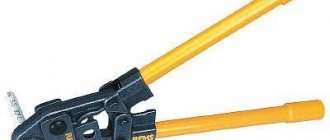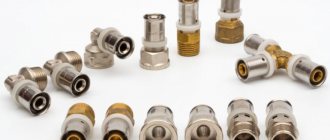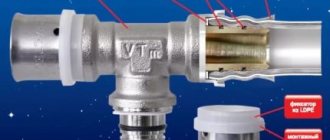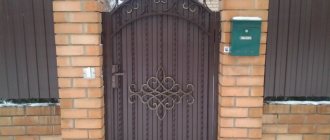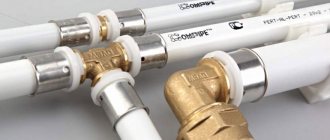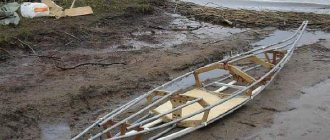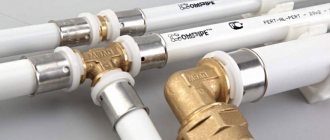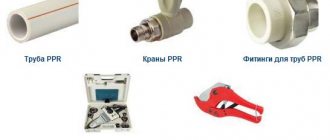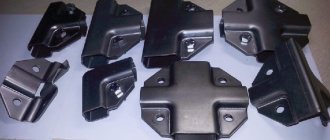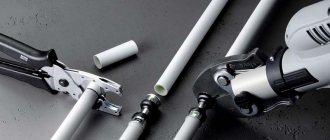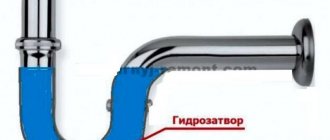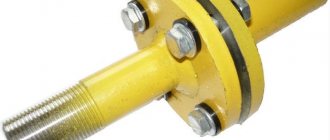When crimping conductors, one of the main conditions for obtaining high-quality contact and its reliable operation in the future is the use of a professional tool.
One of these tools is press pliers or crimpers, designed for crimping bushings, insulated, non-insulated lugs and automotive terminals. Crimpers for automotive terminals and insulated lugs must have matrices with a double-circuit crimping profile - along the core and along the insulation. Also, its geometry and shape must correspond to the crimp part of the tip.
As a rule, it is best to buy sets at once, which include the pliers themselves and all the necessary dies.
Among domestic manufacturers, the KVT company stands out and its two crimping kits:
- press pliers CTF
- press pliers CTB
Let's look at their configuration, differences and principles of operation. Both of these kits are designed for crimping both insulated and non-insulated ferrules.
What materials are plumbing pipes made from?
Work on organizing a water supply system begins with the selection of pipes and suitable fittings.
Then its laying, installation and installation of plumbing is carried out. Modern materials for the water supply system allow all work to be carried out quickly and efficiently. Today, the market offers plumbing pipes made from a variety of materials. If we classify pipes according to their areas of application, we can distinguish three areas: hot and cold water supply networks, sewerage (sewage) and heating systems.
In addition, pipes vary depending on the material from which they are made and their diameter. If we take into account only the material of manufacture, we can distinguish two broad categories: metal and polymer pipes.
Metal pipes.
Copper pipes. Used for internal networks. Compatible only with pipes made of similar material. There are soft and hard copper pipes. Diameter varies from 8 to 32 mm.
Cast iron pipes. Gradually this option is becoming a thing of the past. This is due to the main disadvantages of cast iron - fragility and heavy weight.
Steel pipes. Still in use, but gradually, like cast iron, they are fading into the background. The disadvantage of steel is its susceptibility to corrosion. To avoid this, a type of pipe is currently produced with a galvanized coating on the outside and inside. Steel pipes have high thermal conductivity; Gradually, scale forms on the uneven parts. In addition, they are heavy and difficult to install. Service life up to 40 years.
Polymer pipes.
Polyethylene pipes. Used for both external and internal pipelines. Such pipes can be laid at temperatures down to -20 °C. Diameter from 20 to 160 mm. There are high and low pressure pipes.
Pipes made of cross-linked polyethylene. Used for heating and water supply systems. Such pipes are widely used in snow melting systems and water heated floor systems. To prevent oxygen from penetrating into the system, modern pipes are coated with a diffusion barrier.
Pipes made of metal polymers. Such pipes are new: they were first produced about 9 years ago in England. Essentially, these are the same pipes made of cross-linked polyethylene, only equipped with an additional layer of aluminum foil. The main advantage of metal-plastic pipes is their ability to retain their shape when bent, so they can be used for open installation. In addition, such pipes withstand high pressure and temperature loads, they are impermeable to gases and have insignificant thermal expansion.
PVC pipes. Although such pipes are made from new generation materials, they have already established themselves as a completely safe product for human life and health. PVC pipes are recommended by SNiP for cold and hot water supply and sewerage systems.
The main advantage of the pipes is that their installation does not require special tools: the cold welding method or rubber cuffs are used.
Another advantage of such pipes is their low cost, since polyvinyl chloride is a cheap polymer.
When choosing water and sewer pipes, it is necessary to take into account their features and choose the option that will serve for a long time without breakdowns.
general information
As man created new types of technology, new types of cable connections for various purposes, power and conductivity appeared. In order to connect equipment in accordance with current requirements and standards, it is necessary to prepare the contacts of the leading wires in a special way. To do this, you need to properly crimp their tips . This is precisely why special crimping pliers were created.
This is one of the indispensable tools that many radio amateurs, auto mechanics and electricians must have in their arsenal. With the help of such pliers, you can perform crimping of contacts not only on ordinary cables, but also on specific connectors for non-standard connectors. Despite the fact that in recent years the range of tools for electrical work has expanded significantly, pliers for crimping terminals still remain one of the most popular tools for performing such an operation. This is greatly facilitated by the low cost of their production, availability and high efficiency.
These pliers have a fairly simple design, thanks to which it is possible, even without special electrical knowledge, to crimp the tips. Such a press is a very reliable device with which you can crimp cables quite efficiently. This guarantees a strong connection between all conductors and the connecting structure itself.
Today, there are quite a large number of crimping tool models on sale, which may differ not only in functionality, but also in cost. The latter may depend on several factors:
- press manufacturer;
- type of construction;
- quality and material of the final product.
Installation rules: secrets of specialists
The assembly of metal-plastic pipes using press connections is not technologically difficult. Before starting work, clear the area of debris and dust.
To work you will need tools:
- Pipe cutter For metal-plastic material this is the best option. When cutting such a pipe with a hacksaw, you will not encounter any particular difficulties, but the cut will be unsuitable for installation. you will need to additionally chamfer both sides of the cut, align the cut geometry to the correct circle, and remove all burrs. When using a pipe cutter, you will get a cut of the desired quality without additional processing.
- If you used a hacksaw or other improvised tools to cut the pipe, then you will need a gauge. This tool will straighten the circle and remove the chamfer.
- Press tongs (manual) or electric press machine. For one-time work on small sizes, you can get by with hand tools.
The connection to the crimp sleeve is made according to the following scheme:
- a press sleeve is placed on the outer part of the pipe;
- insert the fitting inside, pushing it all the way;
- crimp the sleeve with pliers.
When using a sliding sleeve, the procedure is as follows:
- a press sleeve is placed on the outer part of the pipe, moving it away from the edge;
- use an expander to increase the diameter of the pipe, insert the fitting all the way (without expansion, the pipe will not fit onto the fitting of the part with a sliding sleeve);
- Using special pliers, pull the press sleeve onto the pipe with the fitting and crimp it.
- The pipe should be cut for each section sequentially during the work, this will allow you to avoid getting confused in the finished sections;
- The fitting is crimped once; repeating this operation will lead to damage to the part;
- The chamfer can be replaced with sandpaper and a sharp knife;
In the summer, work can begin immediately, regardless of where the purchased materials were stored. In winter, you will have to wait several hours for the material to warm up to room temperature. The best solution is to bring in the pipes, fittings, and tools in the evening and leave them to warm up and dry the condensate overnight.
How is crimping done with a handheld device?
The process of crimping a metal-plastic pipe with manual press pliers is not complicated, but it requires attention and accuracy. To work, you need an empty, flat surface that allows you to place a piece of pipe, connecting fittings and the tool itself.
To work correctly with press jaws, appropriate conditions are required, namely a spacious, flat surface and good lighting. In a conveniently equipped place, even a beginner who does not have much repair and installation experience can crimp and install the fitting correctly.
When everything necessary is prepared, the press tongs are placed on the table and the handles are moved apart 180 degrees.
The upper element of the holder is disconnected from the unit and the upper part of the press insert corresponding to the cross-sectional size of the pipe that is currently being processed is inserted into it. The lower half is placed in the lower part of the holder, which remains empty, and the tool is snapped into place.
You can crimp a fitting with press pliers only once. The second processing is categorically unacceptable, so each action should be taken responsibly
A joint assembly is made from a pipe and a fitting and the structure is placed into press jaws, carefully ensuring that the fitting sleeve is inside the press insert.
For high-quality crimping, it is very important to use nozzles that clearly correspond to the cross-sectional diameter of the pipe. Otherwise, the device will deform the fitting and the part will have to be replaced with a new one. After the pipe and fitting set has been correctly placed in the device, the handles are brought together until they stop and crimped
After the set of pipe and fitting is correctly placed in the device, the handles are brought together until they stop and crimped.
After the operation, two identical arcuate bends and two clearly visible annular stripes should form on the metal. And the result will be a clearly and firmly installed and secured fitting, which will be almost impossible to remove with a working tool.
Installation of the fitting must be carried out very carefully, carefully and without haste. Under no circumstances should bias be allowed to occur. Even 5 millimeters will become critical for the pipeline system and in the future will lead to a violation of integrity
You can tell if the work was done incorrectly by a loose, poorly secured nut, by the presence of an opening more than 1 millimeter wide visible between the metal-plastic pipe and the nut, and by the looseness of the nut. If such errors are found, the fitting will have to be cut out of the pipe and a new one reinstalled in its place.
Description of the tip
Most cable lugs are marked with four letters - NSHVI. In the deciphered version, this abbreviation will sound like “insulated pin sleeve tip.” To put it in more understandable terms, this is a regular bushing for a flexible stranded wire. Its main purpose is to protect the end of the cable, which is used for fastening in a screw clamp terminal. After removing the insulation, a ferrule is put on the end of the cable, and then it is crimped with a special device. Most often, press jaws are used for this.
The metal part of the tip is most often made of electrolytic copper. It has insulation only on the back side. The thickness of the insulator is noticeably larger than the diameter of the metal part of the tip. It looks like a cuff. The tip is attached over the insulating coating of the wire. Its metal part is crimped , which fixes it inside the cable core. When creating a connection between the tip and the screw clamp, the entire metal part is hidden in the device socket. Only the safe dielectric part of the cable is visible from the outside.
Required Tools
Connections of metal-plastic pipes, as mentioned above, can be made using fittings of various types, which are selected for each specific case. To assemble the pipeline, you will need the following tools and accessories:
- special scissors, with which metal-plastic products can be cut into pieces of the required length (in addition, such scissors are used to properly prepare pipes for installation);
- a calibrator, necessary to remove dents from the end of the pipe that form after cutting (the calibrator also functions as a kind of reamer, with the help of which a chamfer is removed from the inside of the cut product);
- open-end and adjustable wrenches;
- tape measure, electric drill and pliers;
- press pliers (such a tool for installing metal-plastic pipes will be required if crimp-type fittings will be used in the work; for installing metal-plastic pipes for water supply with your own hands at home, mainly manual press pliers of the mechanical type are used, and in the professional field preference is given hydraulic tools);
- expander (this tool is used when sliding-type fittings are used when working with metal-plastic pipes).
Specific tool for installation of metal-plastic pipes
Trouble-shooting
The table shows some malfunctions and how to resolve them:
| Fault name | Cause | Remedy |
| The cable lug press does not apply maximum pressure or does not pump at all. | There is no oil in the piston sleeve, or it is of the wrong consistency. |
|
| Oil is leaking from under the working piston. | The sealing cuff is defective. |
|
A high-quality and convenient tool for crimping cable lugs is the key to reliable connection of cables and wires of any cross-section.
Types of tools for installing metal-plastic pipes
The following tools are used to connect metal-plastic pipes:
- Pipe cutter or scissors for cutting metal-plastic.
- Angle grinder (grinder).
- Pipe bender
- Construction hairdryer.
- Hand press or press tongs.
The grinder and hair dryer are driven by an electric motor. Household pipe benders for metal-plastic pipes are usually manually driven. The manual crimping press has several varieties with different types of drives.
Mechanical
Manual or mechanical mini pliers are used for crimping water pipes with a diameter of up to 20 mm. These are used for internal distribution of hot and cold water. These tools do not have an electric drive or hydraulic boosters; human muscle power is used to operate them.
Manual drive
Manual pipe benders and homemade Volnov machines have a more complex design than simple tools. The force required for bending is quite significant, and levers are used to operate such structures.
To crimp metal-plastic heating pipes (25 mm, sometimes 32 mm), use a standard manual press for crimping press fittings. To enhance a person’s muscular strength, a gear drive is used, and it also helps to correctly adjust the crimping force.
Hydraulic
For crimping larger diameter pipelines (up to 32 mm), hydraulic models of pliers are produced. A reinforcing hydraulic cylinder is built into one of the pliers handles. When the handles are compressed, the pressure in the hydraulic cylinder increases and the force is transferred to the crimping head of the pliers. Such pliers are quite expensive (from 10,000 rubles), they require qualified maintenance.
Electrohydraulic option
All previous models are used for the installation of metal-plastic engineering systems in small volumes. In industrial construction or if you constantly install plumbing systems, it makes sense to purchase a powerful electro-hydraulic pressing tool. Such equipment is used for installation of pipelines with a diameter of up to 108 mm.
Electro-hydraulic pressing tools have high productivity and the highest quality and tightest compression. The devices are equipped with nozzles for crimping pipes of different diameters. Electric pliers for household running diameters up to 50 mm can be powered by batteries.
Purpose
Press pliers are recommended for installation of metal-plastic structures of any complexity. There are many application options:
- serial connection of water and heat units;
- a collector type system, when connecting and disconnecting each node is possible separately, which allows you to disconnect even one room;
- installation of “warm floors”;
- combined connection method.
Tightness is especially important in the last three options, when the structure, after installation, is completely mounted into the wall or floor covering. Here, the importance of pliers performing the connection using a press fitting is irreplaceable.
Crimping a metal-plastic pipe with press pliers
Tools for crimping - types and features of work
Let's look at how the devices may differ and how the work process is carried out.
It is important to use only high-quality tools and follow technology, this guarantees excellent results
Types of press jaws
In the photo: hand tools are an excellent solution for home use.
The simplest and most widespread option is manual press pliers for metal-plastic pipes.
Let's consider the main features of this type of device:
The simplicity of the design ensures its reliability and durability; there are no many small elements that can break at the most inopportune moment
The cost is quite affordable, which is also important if the volume of work is small and unnecessary costs are undesirable. A very wide range of sizes, although it is best to purchase crimping pliers for metal-plastic pipes with replaceable nozzles
This guarantees the versatility of the tool, since to work with pipes of different diameters you just need to change the nozzle.
The presence of a set of replaceable attachments is an important advantage when choosing a tool
Hydraulic and electromechanical pliers for crimping metal-plastic pipes are characterized by higher productivity, which is why they are most often chosen by professionals. (See also the article Sewer pipes: features.)
They have their own characteristics:
Easier installation process, since crimping is not done using your own effort
The speed of work is much higher, which is important for large volumes of work. The presence of systems that improve the quality of work: OPS - increases the force during crimping, APS - regulates the force depending on the diameter of the pipe, APC - controls the work, the press will not open until the crimping is completed
Professional tool delivers performance
How the work is done
The installation process is quite simple, however, it is important to carry out high-quality preparation so that the result is excellent:
The end of the pipe is processed and the internal chamfer is removed from it. When cutting a pipe, most often its shape is disrupted, so a calibrator is used to give the end an ideal circle
This is very important, and this requirement should under no circumstances be ignored. Next, a crimp sleeve is carefully placed on the end
Then a special fitting with sealing elements is inserted into the pipe. To prevent the end of the pipe from coming into contact with the fitting, a special dielectric gasket is installed. Afterwards, an insert of the required size is installed on the pliers; this is done very simply, and if any questions arise, everything is explained simply and clearly in the instructions. Next, pipe pliers are installed on the coupling, and the connection point is pressed.
It is important to position the clamping jaws correctly on the fitting
History of origin
Pressure testing of installation equipment for heating and water supply systems improves the quality of installation work and increases the speed of their completion. The process involves the use of a crimping press tool. The first such pliers appeared in the 50s of the last century - it was a tool, a prototype of a fitting. In 1964, the equipment received an official patent. A few years later, the Mannesmann brand acquired the rights to the products. The company began refining the equipment, improving technology - and in 1972, a modern version of the press tool appeared.
A man holds a press pliers in his hand
The device consisted of two parts:
- the tool itself with the press;
- hydraulic pump.
A hose was used to connect them. The force created by the hydraulic drive was directed to the tool through the hose, the coupling was compressed with pliers and then fixed to the pipe. In this way a press connection was obtained. Cold pressing is an alternative to welding, soldering, and other operations. The first instruments weighed around 15 kg.
Until the patent expired, Mannesmann and Novopress produced tools under . Later, mites began to mass produce other brands. Now the functionality and design of the device are constantly being refined and improved. At first, the tool was used to work with metal pipes, then metal-plastic rolled products appeared, creating axial fastenings.
Important! In production cycles within the industry, significant changes occur every 5 years, solutions are constantly being refined and modified. Thus, the friction of working parts decreased significantly, and the volume of energy consumption decreased.
After pressing is completed, an engraving remains on the fittings - it allows you to track which pliers were used to perform the work. Manufacturers take into account the wishes of consumers and system tool suppliers. They produce different types of fittings with specific profile configurations. The pliers must be adapted to the contour so that the connection is made correctly. The development of the tool is thus carried out in close cooperation with system suppliers.
Red press pliers with crimping handle
Features of metal press systems
Metal press systems consist of pipes, innovative fittings and special press tools for their installation. It is universal, as it can be used in systems for both heating and water supply. There are no O-rings or cuffs in the system; Safety circuits are provided for quick and reliable crimping of connections. They allow you to detect unpressed fittings during the first leak test. The connections are one hundred percent reliable and durable - manufacturers guarantee a service life of at least 50 years.
Due to the absence of O-rings and internal roundings of large radius, the diameter of the flow section does not narrow, and the water pressure remains strong even at joints and turns.
And since when installing the system, quite a lot of additional and time-consuming operations are eliminated (calibration of pipes and additional adjustment of diameters, installation of O-rings in fittings, etc.), installation time is reduced by almost a third.
